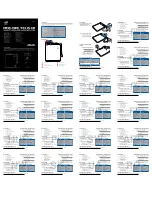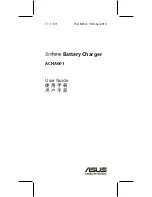
9
S-CHARGER-4ALCD, MSW-CBC-10ALCD, MSW-CBC-6ALCD
S-CHARGER-MI4A
S-CHARGER-2ALED
1.
Diode: charging
2.
Diode: battery charged
3.
Diode: fault
4.
Display
5.
Operating mode selection button
6.
Diodes informing about the state of battery
charge
7.
Diode: 12V / 2A charging mode
8.
Diode: winter mode
9.
Diode: 6V / 2A charging mode
10. Diode: fault
Description of the display for the models S-CHARGER-
4ALCD, MSW-CBC-10ALCD, MSW-CBC-6ALCD,
S-CHARGER-MI4A
A.
Slow 12V charging
B.
Fast 12V charging
C.
Winter mode
D.
6V charging
E.
Faulty battery
F.
Cables are connected incorrectly or the short circuit
protection has worked
G.
Battery voltage value
H.
Battery charge indicator (1 bar – 25%)
3.2 Preparing for use / Device use
•
Connect the lead with the red clamp to the positive (+)
battery terminal
•
Connect the lead with the black clamp to the negative
(-) battery terminal
•
Connect the battery charger to a power source.
•
The charger automatically recognizes the type, voltage
and capacity of the connected battery by adapting its
operating mode.
S-CHARGER-5S1A
•
If everything is working correctly, the charge diode (1)
will light up. When fully charged, the diode (3) will light
up.
•
The lighting diode (2) indicates that an error has
occurred.
S-CHARGER-4ALCD, MSW-CBC-10ALCD, MSW-CBC-6ALCD,
S-CHARGER-MI4A
•
In the case of 12V batteries, the user has the option
of choosing one of three charging modes: fast, slow
or winter mode. The mode is selected by pressing the
operating mode selection button (5).
•
The display shows the current battery parameters,
i.e. voltage and charge level as well as the current
operating mode. If one of the errors occurs, the icon
(E) or (G) will appear on the screen depending on the
reason
S-CHARGER-2ALED
•
After recognizing the battery voltage, one of the diodes
(7) or (9) will light up.
•
In the case of the 12V battery, the user can choose
the winter mode recommended for recharging the
batteries at an ambient temperature between -20°C to
5°C. The mode is selected by pressing the operating
mode selection button (5).
•
During charging, the diodes (6) blink, whereas when
the battery is fully charged already, they light up in the
continuous mode.
•
The lighting diode (10) informs that an error has
occurred.
USE GUIDELINES
•
Connect and disconnect leads with the batterycharger
switched off!
•
Once the battery is fully charged, switch off the battery
charger and only then disconnect the leads from the
battery in the following order: first disconnect the
clamp on the terminal with the same charge as the
vehicle body (in most cases this will be the negative
terminal, however there are vehicles with a positive
charge)
•
Before charging a battery always check whether its
capacity is compatible with the charger. See technical
data tables for the given battery charger model.
1
2
3
4
5
4
5
6
5
7
8
9
10
F
G
H
D
C
B
A
E
2.3 Personal safety
a)
Do not use the device when tired, ill or under the
influence of alcohol, narcotics or medication which
can significantly impair the ability to operate the
device.
b)
When working with the device, use common sense
and stay alert. Temporary loss of concentration whilst
using the device may lead to serious injuries.
c)
This device is not intended to be used by persons
(including children) with limited physical, sensory
or mental aptitude or lack of experience and/
or knowledge, unless they are supervised by
a person responsible for their safety or have received
instruction from this person as to how the device is
used.
d)
Do not overestimate your abilities. When using the
device keep your balance and remain stable at all
times. This will ensure better control over the device
in unexpected situations.
2.4. Safe device use
a)
Do not overload the device. Use appropriate tools for
the given task. A correctly selected device will perform
the task for which it was designed better and in a safer
manner.
c)
Use the cable only in accordance with its designated
use. Never use it to carry the device or to pull the
plug out of a socket. Keep the cable away from heat
sources, oil, sharp edges or moving parts. Damaged
or tangled cables increase the risk of electric shock.
d)
If using the device in a humid environment cannot
be avoided, a residual current device (RCD) should be
applied. The use of an RCD reduces the risk of electric
shock.
2.2. Safety at the workplace
a) Make sure the workplace is orderly and well lit.
A messy or poorly lit workplace may lead to accidents.
Try to anticipate what may happen, observe what is
going on and use common sense when working with
the device.
b)
Do not use the device in an explosion hazard zone,
for example in the presence of flammable liquids,
gasses or dust. The device generates sparks which
may ignite dust or fumes.
c) Upon discovering damage or irregular operation,
immediately switch the device off and report it to
a supervisor without delay.
d)
If there are any doubts as to the correct operation
of the device, contact the manufacturer's support
service.
e)
Only the manufacturer's service point may repair the
device. Do not attempt any repairs independently!
f)
If a fire starts, use solely powder or carbon dioxide
(CO2) fire extinguishers suitable for use on live
devices to put it out.
g) Children or unauthorised persons are forbidden
from entering a work station. (A distraction may
result in a loss of control over the device)
h)
When charging batteries emit gasses which might be
explosive. Avoid contact with sparks and fire.
b)
Do not use the device if the ON/OFF switch does not
function properly (does not switch the device on and
off). Devices which cannot be switched on and off
using the ON/OFF switch are hazardous, should not
be operated and have to be repaired.
c) Make sure the plug is disconnected from the
socket before attempting any adjustments, tool
replacements or before putting the device aside.
Such precautions will reduce the risk of accidentally
activating the device.
d) When not in use, store in a safe place, away from
children and people not familiar with the device, who
have not read the user manual. The device may pose
a hazard in the hands of inexperienced users.
e)
Maintain the device in a good technical state. Before
each use check for general damage and especially
check for cracked parts or elements and for any other
conditions which may impact the safe operation of
the device. If damage is discovered, hand over the
device for repair before use.
f)
Keep the device out of the reach of children.
g)
Device repair or maintenance should be carried out by
qualified persons, only using original spare parts. This
will ensure safe use.
h)
To ensure the operational integrity of the device, do
not remove factory fitted guards and do not loosen
any screws.
i)
Do not charge disposable batteries!
j)
Do not charge faulty or damaged batteries.
k)
Do not charge a frozen battery.
l)
Protect the device against the elements, especially
rainfall. Use the device in well ventilated premises
only.
m) Make sure the battery charger is disconnected from
a power source when connecting leads to a battery.
n)
Never place a battery right under or on top of the
battery charger. Place the battery charger as far away
from the battery as possible. The battery charger may
be a source of sparks or generate an electric arc
o)
Never place the battery charger under the bonnet
3. Use guidelines
The charger is a device designed for charging batteries and
accumulators. The main purpose of the S-CHARGER-5S1A
model is recharging the battery for its maintenance and
maintaining good condition.
The user is liable for any damage resulting from
nonintended use of the device.
3.1 Device description
Description of the control panel
S-CHARGER-5S1A
8
REMEMBER!
When using the device, protect children
and other bystanders.
Rev. 30.08.2018
Rev. 30.08.2018



































